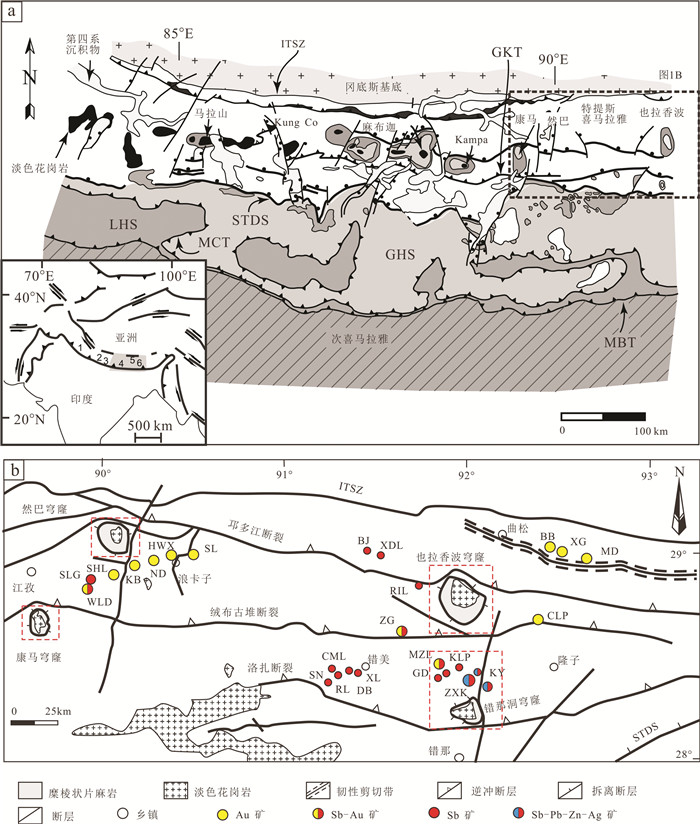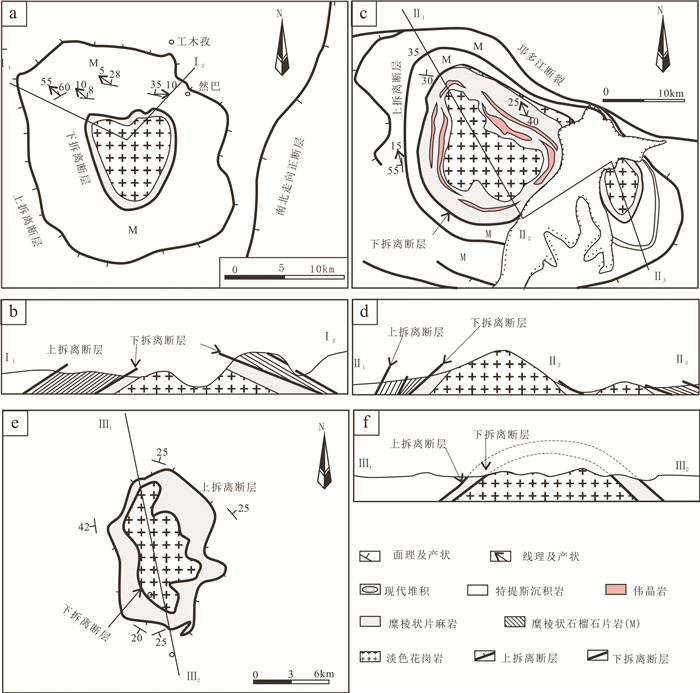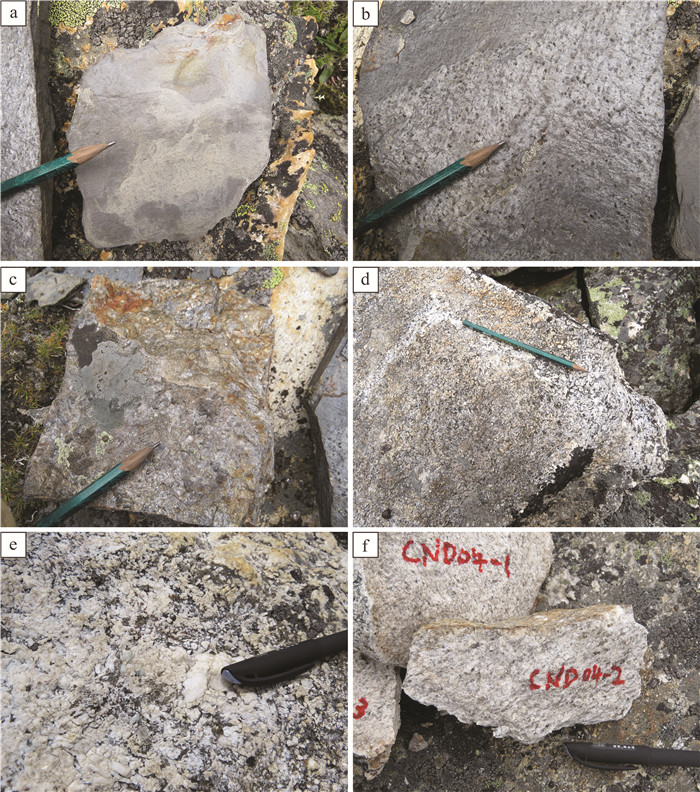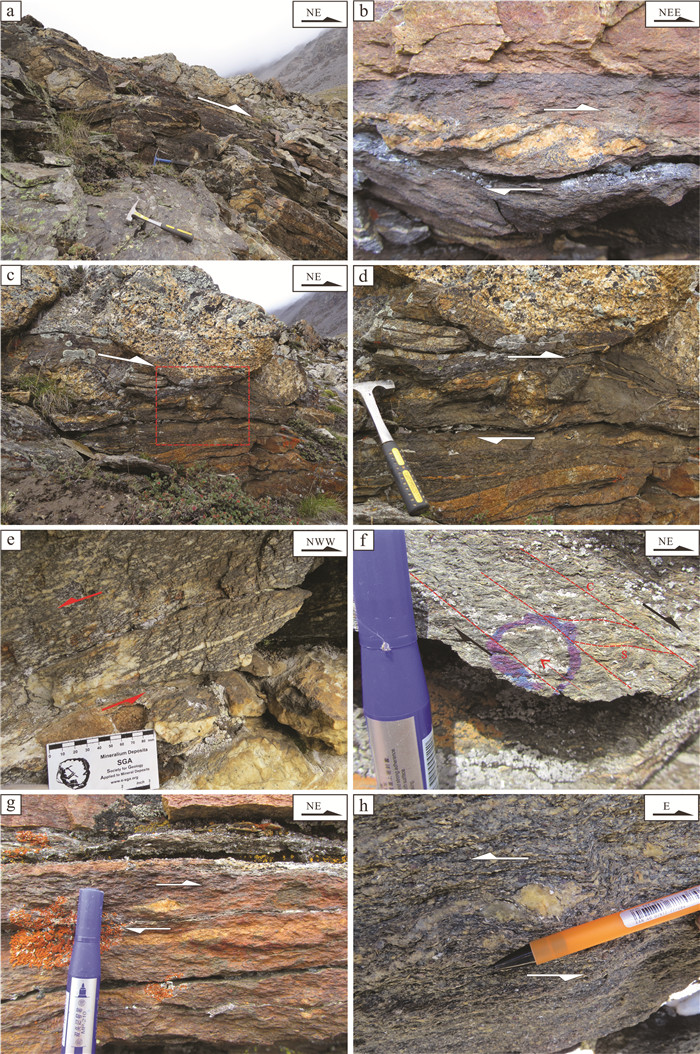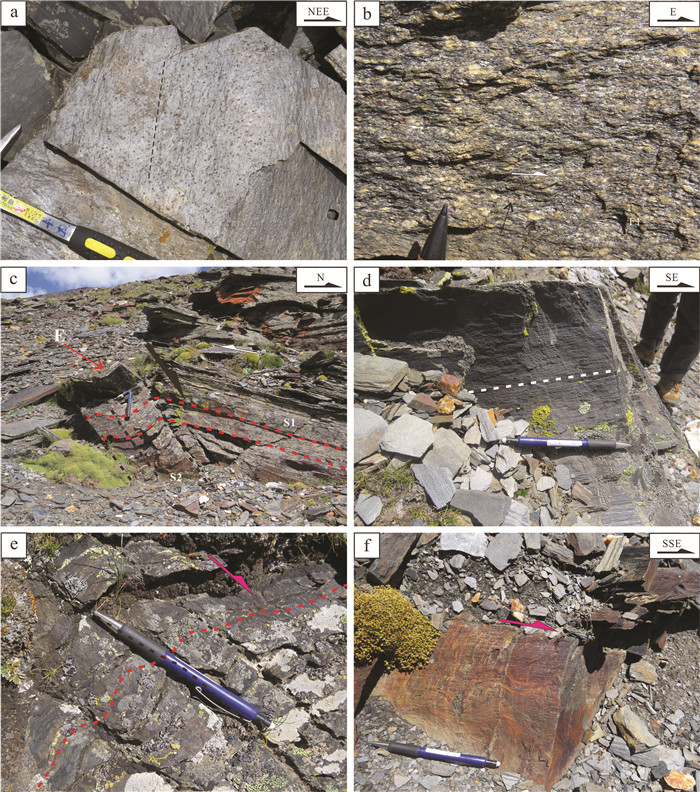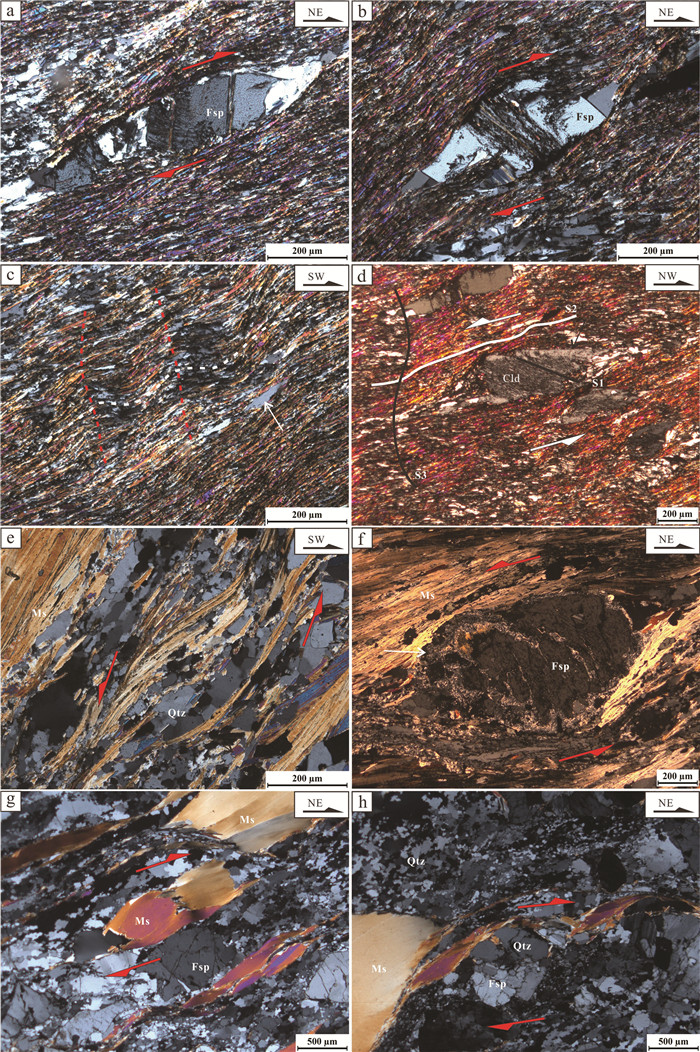Establishment of the North Himalayan double gneiss domes: evidence from field identification of the Cuonadong dome, south Tibet
-
摘要:
错那洞穹隆属于北喜马拉雅片麻岩穹隆带(NHGD)的东南部重要组成部分,是本次研究首次发现并确立的穹隆构造。穹隆位于藏南扎西康矿集区南部,由外向内被两条环形断裂划分为三个岩石-构造单元:特提斯喜马拉雅沉积岩系上部单元、中部单元以及核部,其中内侧断裂为下拆离断层,外侧为上拆离断层。上部单元主要由侏罗系日当组的泥质粉砂质板岩和片岩组成,由外向穹隆中心靠近,根据变质矿物组合特征,其岩性呈较明显的渐变过程,即含或者不含变质矿物的泥质粉砂质板岩、含堇青石粉砂质板岩、含石榴石堇青石粉砂质板岩和含石榴石黑云母粉砂质板岩;中部单元从上至下岩石变质程度逐渐加深,构造变形依次增强,岩性依次为日当组低-高变质的片岩(包括含石榴石黑云母石英片岩、含蓝晶石-十字石二云母石英片岩、含矽线石二云母二长片麻岩)、含电气石(化)花岗质黑云母片麻岩、石榴石云母片麻岩和糜棱状石英二云母片麻岩,其典型变质矿物有石榴石、十字石、矽线石和蓝晶石;核部主要由糜棱状花岗质片麻岩夹少量的副片麻岩和错那洞淡色花岗岩组成。错那洞穹隆主要发育四期线理构造:近N-S向逆冲、N-S向伸展线理、近E-W向线理和围绕核部向四周外侧倾伏线理,分别对应了穹隆构造经历的四期主要变形:初期向南逆冲、早期近N-S向伸展、主期近E-W向伸展和晚期滑塌构造运动,其中主期近E-W向伸展对应于错那洞穹隆的形成,其动力学背景可能是印度板块斜向俯冲及由俯冲引起的中地壳向东流动双重作用。错那洞穹隆的发现和确立丰富了NHGD近E-W向伸展构造,进一步将NHGD划分为由近N-S向伸展所形成的穹隆带(简称NS-NHGD)和近E-W向伸展所形成的穹隆带(EW-NHGD)。
-
关键词:
- 穹隆 /
- E-W向伸展 /
- 错那洞 /
- 扎西康 /
- 北喜马拉雅片麻岩穹隆带(NHGD)
Abstract:The Cuonadong dome, which is firstly reported in this study, is exposed as an east-southern important part of the North Himalayan gneiss domes (NHGD), . The Cuonadong dome is located in the southern part of the Zhaxikang ore concentration area, which is divided into three tectono-lithostratigraphic units by two circle faults around the dome, which is geometrically from upper to lower (or from outer to inner) in order of cap rocks, decollement system and core, with the outer fault being upper detachment fault and the inner fault being lower detachment fault. The Cuonadong dome is a magmatic orthogneiss and leucogranite mantled by orthogneiss and metasedimentary rocks, which in turn are overlain by Jurassic metasedimentary and sedimentary rocks. The grades of metamorphism and structural deformation increase towards the core, which is consistent with the low to high degree metamorphic schist, tourmaline granitic biotite gneiss, garnet mica gneiss, and mylonitic quartz mica gneiss of the Ridang Formation. Their typical metamorphic minerals include garnet, staurolite, sillimanite and kyanite. The Cuonadong dome has preserved evidence for four major deformational events:southward thrust, early approximately N-S extensional deformation, main approximately E-W extensional deformation, and late collapse structural deformation around the core of the Cuonadong dome, which are consistent with four groups of lineation, respectively. The form of the Cuonadong dome resulted from the main E-W extension which resulted from eastward flow of middle or lower crust from beneath Tibet accommodated by northward oblique underthrusting of Indian crust beneath Tibet. The establishment of the Cuonadong dome has enhanced and enriched the significance of the E-W extension of the NHGD, which is further divided into two structural dome zones according to the different extensional directions:approximately NS extensional North Himalayan gneiss domes (NS-NHGD) and E-W extensional North Himalayan gneiss domes (EW-NHGD).
-
Keywords:
- dome /
- E-W extension /
- Cuonadong /
- Zhaxikang /
- North Himalayan gneiss domes (NHGD)
-
1. 引言
硫化物尤其是黄铁矿广泛发育于造山型金矿床、浅成低温热液型金矿床、卡林型金矿床、斑岩型铜金矿床等热液矿床,通常作为载金矿物贯穿于矿床形成的各个阶段(Large et al., 2009;2013;Genna et al., 2015;Wu et al., 2019;Xu et al., 2020)。因此研究黄铁矿对于揭示成矿机理、约束成矿过程、探索成矿物质来源具有重要意义。
萨瓦亚尔顿金矿床位于中国新疆与吉尔吉斯斯坦边境线附近中方一侧,20世纪90年代发现。近期勘探已探明金储量127 t,远景资源量约350 t(Rui et al., 2002;陈华勇等,2013;薛春纪等,2014a),是新疆一个世界级造山型金矿床(刘家军等,2002a;Yang et al., 2007;Liu et al., 2007;陈华勇等,2013;薛春纪等, 2014b, 2015;李俊健等,2021)。前人对萨瓦亚尔顿金矿床地质特征(刘家军等,2002a;杨富全等,2005)、地球化学(叶锦华等,1999a;郑明华等,2002;Chen et al., 2012b)、成矿时代(叶锦华等,1999b;刘家军等,2002b;杨富全等,2006)、成矿流体(陈华勇等, 2007, 2013;Chen et al., 2012a)等方面做了较多研究,但对于广泛发育的黄铁矿研究还很缺乏。宏观上通过矿物组合及穿插关系,刘家军等(2002a)划分出5种含金矿物组合:金-毒砂-黄铁矿-石英、金-黄铁矿-脆硫锑铅矿-(辉锑矿)-石英、金-脆硫锑铅矿-(辉锑矿)、金-石英-菱铁矿和金-黄铁矿-磁黄铁矿-石英。郑明华等(2002)据矿化脉穿插关系,将矿化分为无矿石英、金-黄铁矿-毒砂-石英、金-多硫化物-石英-(菱铁矿)、辉锑矿-石英、石英-菱铁矿等5个阶段。可以看出黄铁矿等硫化物发育于成矿各个阶段,但对于不同阶段硫化物类型、特征缺乏细致研究。郑明华等(2001)对矿石中黄铁矿、毒砂等进行了电子探针分析,指出毒砂为载金矿物,而黄铁矿不是载金矿物。王玉山等(2008)提出与金矿化最密切的为黄铁矿、毒砂、辉锑矿等硫化物,金在黄铁矿、毒砂中以“不可见金”的形式存在。可见硫化物是主要载金矿物,但是金的赋存状态存在争议,而硫化物中其他微量元素的含量及变化未见报道。
本文主要针对矿石中载金硫化物开展系统的岩/矿相学观测,通过宏观穿插关系到微观粒度、晶形、交生关系、共/伴生矿物组合等方面的研究,区分出不同阶段和不同世代的载金硫化物矿物,采用电子探针(EMPA)、激光剥蚀等离子质谱(LA-ICP-MS)和场发射扫描电镜(FESEM)对不同阶段和世代的载金硫化物载金性及微量元素含量进行了系统的分析,旨在示踪成矿物质来源,精细刻画成矿过程。
2. 区域和矿床地质
萨瓦亚尔顿金矿床位于中国新疆西南天山,接近中国—吉尔吉斯斯坦边界(图 1)。区域前寒武纪基底出露于矿区东南部,由中元古代长城系片岩、片麻岩及大理岩组成,上覆古生代厚层复理石及碳酸盐岩建造(Yang et al., 2007)。随着南天山洋俯冲消减闭合,塔里木板块与中天山板块在晚石炭世闭合,导致区域发生强烈的变形-褶皱及逆冲推覆构造,地层整体发生绿片岩相浅变质作用(高俊等,2006;Yang et al., 2007;Gao et al., 2009;牛树银等,2013)。阿热克托如克和伊尔库什坦断裂与萨瓦亚尔顿金矿空间位置最为密切,断裂呈南西走向,倾向北西,显示走滑剪切性质(Liu et al., 2007;Chen et al., 2012a)(图 1)。中生代河流-湖泊相碎屑沉积岩发育于区域东南部,被塔里木盆地新生代陆相碎屑岩覆盖(图 1;Yang et al., 2007)。
![]() 图 1 萨瓦亚尔顿地区区域地质简图(据陈华勇等,2013修编)Figure 1. Sketch map of western part of the Chinese Southern Tianshan showing the location of the Sawayaerdun gold deposit (modified from Chen Huayong et al., 2013)
图 1 萨瓦亚尔顿地区区域地质简图(据陈华勇等,2013修编)Figure 1. Sketch map of western part of the Chinese Southern Tianshan showing the location of the Sawayaerdun gold deposit (modified from Chen Huayong et al., 2013)萨瓦亚尔顿金矿床赋矿地层为一套古生代发生绿片岩相浅变质作用的浊积岩系(Liu et al., 2007;彭静等,2010)。地层时代存在不同认识,最新发表的U-Pb碎屑锆石年龄数据限定矿区西北部F2断层上盘的地层为中泥盆统,矿区西南部F2断层下盘的地层为下石炭统(图 2a;Zhang et al., 2017)。矿区西北部中泥盆统主要为灰色—深灰色中—薄层粉砂质板岩夹黑色炭质板岩。中部下石炭统为炭质板岩与薄层状粉砂质板岩互层,是主要的赋矿层位。矿区东南部中泥盆统主体为一套碳酸盐岩,接近F1断层处下石炭统近直立,粉砂质板岩占比例增大且有钙质粉砂岩顺层产出,而碳酸盐岩呈陡立的孤峰,岩石普遍破碎或沿节理裂开。
![]() 图 2 萨瓦亚尔顿金矿床地质简图(a)萨瓦亚尔顿金矿区IV号矿带23勘探线剖面图(b)(据新疆地质矿产局第二地质大队,2014修改)Figure 2. Sketched map showing the geology of the Sawayaerdun gold deposit (a) and Geological section along No.23 exploration line of the IV mineralized belt in the Sawayaerdun gold deposit (b) (modified from Geological Team No.2, Xinjiang Bureau of Geology and Mineral Resources, 2014)
图 2 萨瓦亚尔顿金矿床地质简图(a)萨瓦亚尔顿金矿区IV号矿带23勘探线剖面图(b)(据新疆地质矿产局第二地质大队,2014修改)Figure 2. Sketched map showing the geology of the Sawayaerdun gold deposit (a) and Geological section along No.23 exploration line of the IV mineralized belt in the Sawayaerdun gold deposit (b) (modified from Geological Team No.2, Xinjiang Bureau of Geology and Mineral Resources, 2014)矿区发育一系列韧脆性逆冲推覆构造,大多数南西走向,倾向北西,部分倾向南东(Liu et al., 2007)(图 2a)。局部断裂构造极为发育,不同类型、不同性质的断裂构造先后形成于不同的构造环境之中,并且在时空演化上多期复合叠加活动明显。岩石变形形成的面理和线理极为发育,A型小褶皱广泛分布,赋矿地层中板岩和千枚岩由于动力变质作用形成碎斑结构,岩石变形的强弱带呈交替出现等都显示了矿区韧性剪切带的发育(Yang et al., 2007)。
矿区内未见大型侵入体出露,只有少量镁铁质岩枝/岩脉出露于矿区西南部,走向北东或近南北向(图 2a)(Liu et al., 2007)。K-Ar同位素测年得到(207.5±4.2) Ma~(187±18) Ma和(164.4±2.6) Ma~(137.9±3.8) Ma两期年龄,可能记录了印支期及燕山期构造-岩浆热事件(Liu et al., 2007)。陈富文和李华芹(2003)对矿区出露的二长斑岩脉进行了单颗粒锆石U-Pb测年,得到133.7~131.0 Ma的结晶年龄,提出岩浆侵位发生在晚侏罗世—早白垩世。属燕山中晚期岩浆活动产物。
金矿化赋存于一系列南西走向,倾向北西的韧性剪切带之中,这些韧性剪切带及矿体同时被代表晚期破矿构造的北西走向脆性断裂所切断(图 2a)。矿区沿着主要的逆冲推覆构造圈定出24个矿体。其中四号矿体长度超过4000 m,宽度变化于20~100 m,是矿区已知最大矿体,单个矿体具有超过70 t的金资源量,品位变化于1.4~5.9 g/t (叶锦华等,1999a;Liu et al., 2007;Yang et al., 2007)。矿体呈似层状、透镜状或脉状产出,走向南西,倾向北西,倾角介于60~70°(图 2b)。
主要的赋矿岩系炭质板岩之中含有少量黄铁矿(图 3a),可能为沉积/成岩期产物。单个矿体主要由大量含金石英脉、石英细脉和少量方解石脉组成(石英脉型矿石),还有硫化物矿物呈浸染状分布于围岩之中(蚀变岩型矿石)。矿体中硅化和硫化物矿化(主要为黄铁矿化、毒砂化)的炭质板岩(图 3b)、石英-硫化物脉(细脉)(图 3c)及石英脉(图 3c)平行或近平行于片理且同时发生强烈变形(揉皱及石香肠化),后被显示脆性性质的石英-硫化物细脉切穿(图 3d、e、f)。
![]() 图 3 萨瓦亚尔顿矿石、围岩手标本照片a—炭质板岩,含有早期成岩期浸染状黄铁矿;b—黄铁矿与毒砂呈浸染状分布于蚀变岩石中,并与蚀变岩一起揉皱变形;c—近平行于片理的石英-硫化物细脉;d—石英-硫化物细脉;e—切穿片理的黄铁矿-毒砂-石英细脉;f—石英-硫化物细脉、网脉切穿片理及蚀变岩Figure 3. Photographs showing various types of ores and host rocks from the Sawayaerdun gold deposita-Carbonaceous slate with early diagenetic pyrite disseminated in it; b-Pyrite and arsenopyrite disseminated in the altered rock that has been foliated and folded; c-Quartz-sulfide veinlet subparallel to the foliation; d-Quartz-sulfide veinlets; e-A quartz-pyrite-arsenopyrite vein crosscutting the foliation; f-Quartz-sulfide veinlets and stockworks crosscutting the foliation and altered rock
图 3 萨瓦亚尔顿矿石、围岩手标本照片a—炭质板岩,含有早期成岩期浸染状黄铁矿;b—黄铁矿与毒砂呈浸染状分布于蚀变岩石中,并与蚀变岩一起揉皱变形;c—近平行于片理的石英-硫化物细脉;d—石英-硫化物细脉;e—切穿片理的黄铁矿-毒砂-石英细脉;f—石英-硫化物细脉、网脉切穿片理及蚀变岩Figure 3. Photographs showing various types of ores and host rocks from the Sawayaerdun gold deposita-Carbonaceous slate with early diagenetic pyrite disseminated in it; b-Pyrite and arsenopyrite disseminated in the altered rock that has been foliated and folded; c-Quartz-sulfide veinlet subparallel to the foliation; d-Quartz-sulfide veinlets; e-A quartz-pyrite-arsenopyrite vein crosscutting the foliation; f-Quartz-sulfide veinlets and stockworks crosscutting the foliation and altered rock可见金主要以自然金或者银金矿的形式存在于石英脉裂隙中或者硫化物裂隙及内部(Liu et al., 2007),“不可见金”的存在形式仍有待揭示。分布于矿体及围岩中的硫化物主要包括黄铁矿、毒砂、磁黄铁矿、黄铜矿、闪锌矿、方铅矿等,研究中也发现少量脆硫锑铅矿。此外,Liu et al. (2007)还发现少量白铁矿、辉锑矿、方钴矿、银黝铜矿、辉铋矿、自然铋等矿物。其中,最常见的含金硫化物为黄铁矿及毒砂(Liu et al., 2007;Yang et al., 2007)。根据硫化物产出状态和穿插关系,可判断其先后顺序为:(1)浸染状(局部且不连续)分布于炭质板岩的黄铁矿(图 3a);(2)与硅化及石英脉一起经历强烈揉皱变形的硫化物(图 3b、c);(3)与非变形石英脉及石英细脉共生的硫化物(图 3d、e、f)。
根据主要硫化物矿物的大小、晶形、产状及交生关系,矿石中黄铁矿可划分出3个世代:第一期黄铁矿(Py0)呈球丛状沿地层片理分布(图 4a, b)。第二期黄铁矿(Py1)通常显示他形晶结构,磨光差,发育大量裂纹与孔洞(图 4c),孔洞多集中于矿物边部(图 4e、h),可见被后期黄铜矿充填交代(图 4d)。Py1与自形—半自形毒砂(Apy1)共生,毒砂也显示破碎的表面(图 4d)。在局部可见Py1因变形作用拉伸的现象(图 4e)。第三期黄铁矿(Py2)呈自形-半自形晶型且具有保存良好的晶体结构,与Py1相比表面干净,没有裂纹(图 4e, f),与自形毒砂(Apy2)共生。Re-Os法测得第二期黄铁矿(Py1)和第三期黄铁矿(Py2)形成年龄分别为(323.9±4.8)Ma与(282±12)Ma(Zhang et al., 2017)。
![]() 图 4 显微照片显示产于矿石及围岩中各种硫化物特征a-b—球丛状黄铁矿(Py0);c—他形黄铁矿(Py1),与自形—半自形黄铁矿共存(Py2);d—他形黄铁矿(Py1)与自形黄铁矿(Py2)共生,并被黄铜矿(Cp)交代;e—他形黄铁矿(Py1)在变形过程中被拉长;f—自形黄铁矿(Py2)与毒砂共生(Apy2);g—他形黄铁矿(Py1)与方铅矿及闪锌矿共生;h—他形黄铁矿(Py1)被自形黄铁矿(Py2)包裹;i—自形黄铁矿(Py2)包含方铅矿及毒砂包体;黄色实圈为LA-ICP-MS点,简写:Py=黄铁矿;Apy=毒砂;Gn=方铅矿;Cp=黄铜矿;Sp=闪锌矿。a-b, e-g: 反射光;c-d, h-i: BSE图像Figure 4. Photomicrographs showing various occurrences of sulfides in the ores and host rocksa- b- Framboidal pyrite (Py0); c- Anhedral pyrite (Py1) coexisting with euhedral- subhedral pyrite (Py2); d- Py1 and Apy1 in coexistence and replaced by Cp; e-Anhedral pyrite (Py1) stretched during deformation; f-Euhedral pyrite (Py2) coexisting with arsenopyrite (Apy2); g-anhedral pyrite (Py1) coexisting with sphalerite and galena; h-Euhedral pyrite (Py2) overgrowing anhedral pyrite (Py1); i-Subhedral pyrite (Py2) containing inclusions of galena and arsenopyrite. Yellow rim represents LA- ICP- MS spot, Abbreviations: Py=Pyrite; Apy=Arsenopyrite; Gn=Galena; Cp= Chalcopyrite; Sp=Sphalerite. a-b, e-g: Reflected light; c-d, h-i: BSE imagines
图 4 显微照片显示产于矿石及围岩中各种硫化物特征a-b—球丛状黄铁矿(Py0);c—他形黄铁矿(Py1),与自形—半自形黄铁矿共存(Py2);d—他形黄铁矿(Py1)与自形黄铁矿(Py2)共生,并被黄铜矿(Cp)交代;e—他形黄铁矿(Py1)在变形过程中被拉长;f—自形黄铁矿(Py2)与毒砂共生(Apy2);g—他形黄铁矿(Py1)与方铅矿及闪锌矿共生;h—他形黄铁矿(Py1)被自形黄铁矿(Py2)包裹;i—自形黄铁矿(Py2)包含方铅矿及毒砂包体;黄色实圈为LA-ICP-MS点,简写:Py=黄铁矿;Apy=毒砂;Gn=方铅矿;Cp=黄铜矿;Sp=闪锌矿。a-b, e-g: 反射光;c-d, h-i: BSE图像Figure 4. Photomicrographs showing various occurrences of sulfides in the ores and host rocksa- b- Framboidal pyrite (Py0); c- Anhedral pyrite (Py1) coexisting with euhedral- subhedral pyrite (Py2); d- Py1 and Apy1 in coexistence and replaced by Cp; e-Anhedral pyrite (Py1) stretched during deformation; f-Euhedral pyrite (Py2) coexisting with arsenopyrite (Apy2); g-anhedral pyrite (Py1) coexisting with sphalerite and galena; h-Euhedral pyrite (Py2) overgrowing anhedral pyrite (Py1); i-Subhedral pyrite (Py2) containing inclusions of galena and arsenopyrite. Yellow rim represents LA- ICP- MS spot, Abbreviations: Py=Pyrite; Apy=Arsenopyrite; Gn=Galena; Cp= Chalcopyrite; Sp=Sphalerite. a-b, e-g: Reflected light; c-d, h-i: BSE imagines综合以上分析,Py0为最早期黄铁矿,可能为同生/成岩期产物。他形黄铁矿(Py1)与自形黄铁矿(Py2)为热液期产物。他形黄铁矿(Py1)形成于变形期(同碰撞期),而自形黄铁矿(Py2)很可能形成于主变形期之后(晚/后碰撞期)。Py0所占比例远小于Py1和Py2。矿物的主要生成顺序列于图 5。
![]() 图 5 萨瓦亚尔顿金矿床矿物生成顺序(线条粗细代表矿物含量相对多少,虚线代表矿物可能存在,断线代表矿物只存在于某个阶段)Figure 5. Paragenetic sequence of minerals in the Sawayaerdun gold deposit(The thickness of the line represents the relative content of the mineral, the dotted line represents the possible existence of the mineral, and the broken line represents the mineral only exists in a certain stage)
图 5 萨瓦亚尔顿金矿床矿物生成顺序(线条粗细代表矿物含量相对多少,虚线代表矿物可能存在,断线代表矿物只存在于某个阶段)Figure 5. Paragenetic sequence of minerals in the Sawayaerdun gold deposit(The thickness of the line represents the relative content of the mineral, the dotted line represents the possible existence of the mineral, and the broken line represents the mineral only exists in a certain stage)3. 样品分析及结果
3.1 样品和分析方法
本次研究的矿石样品采自IV号矿体23勘探线中段平硐,显微镜下观察其中主要脉石矿物为石英、方解石,硫化物矿物主要为黄铁矿、毒砂,少量黄铜矿、方铅矿、闪锌矿、脆硫锑铅矿、磁黄铁矿等。显微镜下没有见到自然金或银金矿独立矿物。
将矿石标本磨制成探针片及光片,先在显微镜下观察和圈定待测位置,喷碳后进行电子探针、激光剥蚀等离子质谱和场发射扫描电镜分析。在中国地质科学院矿产资源研究所完成电子探针分析,仪器型号为JXA-8230,加速电压20 kV,电流20 nA,束斑直径3~5 μm,分析元素对应的标样矿物为金属、化合物及天然硫化物,其中金含量检测下限取257×10-6。分析包括点分析、线扫描和对典型矿物Au、As、S、Fe元素的面扫描。
硫化物LA-ICP-MS分析在国家地质实验测试中心完成,使用仪器为Thermo Element Ⅱ等离子质谱仪,激光剥蚀系统为NEW WAVE UP-213。实验采用He作为剥蚀物质的载气,激光波长213 nm、束斑40 μm、脉冲频率10 Hz、能量0.176 mJ、密度23~25 J/m2,测试过程中首先遮挡激光束进行空白背景采集15 s,然后进行样品连续剥蚀采集45 s,停止剥蚀后继续吹扫15 s。清洗进样系统,单点测试分析时间75 s。等离子质谱测试参数为冷却气流速(Ar)15.55 L/min;辅助气流速(Ar)0.67 L/min;载气流速(He)0.58 L/min;样品气流速0.819 L/min,射频发生器功率1205 W。测试数据采用内标外标相结合的方法,内标为Fe元素,外标样使用NIST 612。测试元素包括Ag、As、Bi、Co、Cu、Ga、Mn、Mo、Ni、Pb、Sb等微量元素,由于缺乏有效的Au标样,金的含量没有检测。
在中国地质大学(北京)地质过程与矿产资源国家重点实验室完成FESEM分析,所用仪器型号ZEISS SUPRA 55,加速电压15 kV,工作距离14.9 mm;元素半定量分析在Oxford能谱分析仪(EDS)上完成,工作电压10 kV,工作距离8.5 mm。
3.2 硫化物EMPA分析结果
对10个矿石样品中黄铁矿进行了77个点的电子探针分析,结果见表 1。除了S、Fe外,黄铁矿中普遍含As(0.03%~1.17%,平均0.165%)、Au(0.03%~0.13%,平均0.052%)和Co(0.03%~0.16%,平均0.078%),其他微量元素Se、Ge、Pb、Sb、Bi、Cu、Zn和Ni含量低,在检出限上下浮动。不同世代黄铁矿中S(53.0±1.2%)、Fe(46.2±0.7%)含量比较稳定,而As含量变化较大。其中Py0、Py1显示S-As负相关关系(图 6a),而Fe、As没有明显的相关关系。有32个点Au含量高于检测限,剔除个别高值点,Au在不同世代黄铁矿中平均含量基本相当(Py1平均0.050%; Py2平均0.052%)。对自形—半自形中粗粒黄铁矿(Py2)核部到边部线扫描发现,Au的分布波动大,由核部至边部金含量有的升高(图 7a),有的核部及边部Au含量高而中间含量低(图 7b),有的核部及边部Au含量低而中间含量高(图 7c),另一些核部至边部Au含量降低(图 7d)。
表 1 萨瓦亚尔顿金矿黄铁矿、毒砂电子探针成分分析结果(%)Table 1. EMPA analytical results of pyrite and arsenopyrite in Sawayaerdun gold deposit(%)
9个矿石样品中毒砂的45个测点的电子探针分析结果见表 1。相对于Apy2(平均As=41.85%、S=22.33%、Fe=35.66%),Ayp1具有相对高含量的As(平均42.05%)、相对低含量的S(平均22.23%)和Fe(平均35.62%)。相对于黄铁矿,毒砂普遍富集Sb,且Apy2中Sb平均含量(0.14%)比Apy1(0.08%)的高。Co同时赋存于黄铁矿(平均0.08%)和毒砂(平均0.07%)中,而其他微量元素如Se、Ge、Pb、Bi、Zn、Cu、Ni仅部分测点可少量检测到含量。24个(共45)毒砂测点的金含量高于检测线,变化于0.03%~0.14 %,平均0.033%,金的平均含量较黄铁矿中的高。Apy2的平均Au(0.035%)含量高于Apy1(0.027%)。对粗粒自形—半自形毒砂(Apy2)由核部到边部电子探针线扫描发现Au的含量变化大,无明显规律,与Py2类似。
为了解Au等元素在黄铁矿及毒砂中的分布,对金矿石中黄铁矿及毒砂颗粒进行了电子探针面扫描,扫描结果见图 8。黄铁矿EMPA面扫描结果(图 8a)显示,除了黄铁矿主要组成元素S、Fe外,As和Au基本均匀分布于整个黄铁矿颗粒中,使整个黄铁矿As、Au色调明显比周围脉石矿物高,而自形黄铁矿(Py2)核部(Py1)并没有显示出独特的元素分布特点。这与电子探针对Py1和Py2点分析的结果基本一致。毒砂EPMA面扫描结果见图 8b。组成毒砂主要元素Fe的含量非常均匀,S表现为一个高含量的核部与低含量的边部,而As表现为一个低含量的内核和高含量的边部,这与LA-ICP-MS点分析结果一致(图 8b)。Au分布与黄铁矿中Au分布类似,都表现均匀分布的特点。
3.3 硫化物LA-ICP-MS分析结果
6件样品中黄铁矿的LA-ICP-MS测点分析结果列于表 2。除了Ga、Mo、In等元素含量较低且有较多低于检出限外,其他元素包括Ag、As、Bi、Co、Cu、Mn、Ni、Pb、Sb、V、Zn、Sn等都可以较好地反映出不同类型黄铁矿的微量元素特征。
表 2 萨瓦亚尔顿金矿黄铁矿、毒砂LA-ICP-MS分析结果(10-6)Table 2. LA-ICP-MS analytical results of pyrite and arsenopyrite in Sawayaerdun gold deposit(10-6)
沉积期黄铁矿Py0具有相对较高的Ag(平均3.2×10-6)、As(平均8218×10-6)、Bi(4.29×10-6)、Co(平均67.66×10-6)、Cu(平均17.65×10-6)、Ni(平均255×10-6)、Pb(平均180×10-6)、Sb(259×10-6)、Zn(9.06×10-6)含量,Co/Ni比值介于0.198~1.196,平均为0.427;Py1中As的含量(平均3111×10-6)远低于Py0,Ag(平均0.9×10-6)、Cu(平均6.23×10-6)、Ni(平均93.72×10-6)、Pb(30.90×10-6)、Sb(平均62.45×10-6)含量低于Py0,但Co(平均461×10-6)、Zn(22.78×10-6)含量高于Py0,Co/Ni比值介于0.002~14.141;Py2中As的含量(除去两个异常高点,平均为1946×10-6)远低于Py0与Py1,其Co(平均30.09×10-6)低于Py0,远低于Py1;Ni(132×10-6)、Pb(平均116×10-6)、Sb(170×10-6)三组元素含量低于Py0,高于Py1;Cu(平均5.48×10-6)及Zn(平均7.39×10-6)含量是三类黄铁矿中最低的,Py2的Co/Ni介于0.001~2.11。所有样品的Co/Ni介于0~15,其中Py0投于Co/Ni=0.1与Co/Ni=1线之间,Py1与Py2点投点相对分散(图 9a)。在Pb-Bi联合图解中,两者表现出正相关关系(图 9b)。
两期毒砂相对富集Bi、Co、Ni、及Sb,Apy1的Bi(平均12.22×10-6)、Co(平均29.28×10-6)、Ni(平均208×10-6)及Sb(平均1269×10-6)含量均小于Apy2(Bi平均28.68×10-6、Co平均278×10-6、Ni平均314×10-6、Sb含量2680×10-6)。相比于黄铁矿,两期毒砂明显更加富集Sb,与电子探针结果吻合。
3.4 硫化物FESEM分析结果
为了进一步揭示“不可见金”在黄铁矿中的存在形式,对开展电子探针面扫描的样品CN-12-1进行了场发射扫描电镜(FESEM)分析。在两万倍的放大倍率下对黄铁矿进行了BSE图像的分析(图 10a),没有发现纳米级颗粒的自然金,同时对目标面(图 10b)进行了能谱扫面,精度为25 nm的面扫描结果显示,金仍然较均匀地分布于整个目标区域内,没有显示金的聚集状态。
4. 讨论
4.1 金的赋存状态
岩金矿石中“不可见金”的赋存状态是研究关注的焦点。在世界各地的卡林型金矿石中,“不可见金”主要以晶格金的形式存在于含砷黄铁矿和毒砂中(Fleet et al., 1997;Simon et al., 1999;付绍宏等,2004;Reich et al., 2005;陈懋弘等,2009;Li et al., 2014;Liang et al., 2014),并伴生有纳米级自然金颗粒(Reich et al., 2005;Liang et al., 2014)。
造山型金矿中金主要以自然金形式产于黄铁矿、毒砂裂隙内或颗粒间,但在早阶段形成的黄铁矿及毒砂中金主要是“不可见金”;由于后期多幕热液和蚀变影响,在温度升高条件下,热液活化萃取先期形成黄铁矿及毒砂中的金形成可见金,主要分布于蚀变环带或者充填于裂隙中(Morey et al., 2008;Cook et al., 2013;卢焕章等,2013)。前人研究认为萨瓦亚尔顿金矿化主要以自然金及银金矿形式存在于毒砂及黄铁矿的微裂隙中(杨富全等,2005;Liu et al., 2007;王玉山等,2008),或者呈粒间金存在于石英颗粒之间(刘家军等,2002a;杨富全等,2005),代表后期热液对先存载金矿物中金的活化萃取再沉淀过程。从早期“不可见金”到晚期可见金的转化过程也得到热力学的证明(Morey et al., 2008),通过硫化物及毒砂之间温度计和平衡条件,先后出现“毒砂+磁黄铁矿(固体包裹体)+不可见金”→“毒砂+黄铁矿+磁黄铁矿+可见金”的矿物组合转化,反应需要温度升高75~100℃,fS2(硫逸度)需要提高6个数量级;fS2的提高可以用毒砂中As的富集和S的亏损来评估,毒砂中S的亏损使热液中fS2升高(Morey et al., 2008)。通过对环带毒砂的EMPA面扫描,低As高S的核部与高As低S的边部反映了边部As富集、S亏损的现象(图 8b);同时萨瓦亚尔顿金矿自然金及银金矿与黄铁矿、毒砂、磁黄铁矿也具有紧密的空间关系(Liu et al., 2007),指示萨瓦亚尔顿金成矿过程中可能存在上述转化反应。Thomas(2001)通过对Bendigo沉积岩中黄铁矿、磁黄铁矿转化研究提出在变质作用条件下黄铁矿转化为磁黄铁矿对Au的萃取效率高达90%。
黄铁矿及毒砂的EMPA点分析数据表明,萨瓦亚尔顿金矿石中3个世代黄铁矿及2个世代毒砂样品近半数含金;自形—半自形中粗粒黄铁矿(Py2)由核部到边部的线分析表明金的含量没有一定的变化规律(图 7)。但是,各个测点普遍含金,表明黄铁矿与毒砂均为载金矿物。EMPA面分析显示载金黄铁矿中金含量不存在明显的集中点/区,显示良好的均质性,但比周围脉石矿物的含金量明显高很多(图 8),暗示金以化学结合态进入黄铁矿中。但是考虑到EMPA面分析精度受到束斑直径的影响(1~2 μm),当金的直径小于束斑直径时可能产生矿物均匀分布的假象(陈懋弘等,2009)。场发射扫描电镜(FESEM)分析表明,在25 nm精度下仍然没有金的聚集态产出。限于样品数量及测试条件,不能排除纳米级自然金存在的可能。根据现有结果,萨瓦亚尔顿金矿中“不可见金”的主要以固溶体(Au+)形式存在于黄铁矿中。
含As黄铁矿中的As进入黄铁矿晶格有两种方式,一种以As-的形式替代S(Simon et al., 1999;Reich et al., 2005; Li et al., 2014;Liang et al., 2014),另一种以As+3的形式替代Fe(Deditius et al., 2008)。Py0、Py1的As-S具有负相关关系(图 6a),而As-Fe没有明显的关联(图 6b)。因此,推测部分黄铁矿存在As替代S进入矿物晶格。一般认为,As的类质同象替代会导致黄铁矿晶格中产生堆垛层错及晶格位错,有利于Au以Au+1的形式进入黄铁矿晶格(Simon et al., 1999;Palenik et al., 2004);萨瓦亚尔顿金矿黄铁矿中As-Au的相关系数仅为0.33,表现出某种较弱的正相关性(图 11),可能并不能作为有效的论据来确定As、Au的替代关系,因此Au以何种方式进入黄铁矿晶格还需要进一步的工作来确定。
4.2 硫化物微量元素特征
LA-ICP-MS剥蚀信号图谱对于微量元素赋存状态的判别具有指示意义(Cook et al., 2009),平滑的信号指示元素主要以类质同象形式存在,信号不平滑或者存在尖峰说明测点存在携带这些元素的显微包裹体。Py0中As、Cu、Ag、Co、Ni与Fe信号基本一致,主要以类质同象形式赋存,同时这些微量元素强度较Py1、Py2高,说明在初始沉积阶段就有微量元素的富集;Pb、Sb、Zn出现尖峰,可能存在方铅矿、辉锑矿、闪锌矿等矿物显微包裹体。相比于Py0,Py1出现As的高峰,说明存在毒砂显微包体,这与观察到的此阶段存在伴生毒砂现象相吻合(图 12)。
黄铁矿中Co、Ni含量受其形成时物理化学条件控制,对矿床的成因类型判定具有一定指示意义(Bralia et al., 1979)。沉积成因黄铁矿的Co/Ni比值小于1,平均0.63(Loftus-Hills and Solomon, 1967),而热液成因黄铁矿Co/Ni比值通常具有一个较大的范围,多大于1,也可远小于1(Bralia et al., 1979)。萨瓦亚尔顿金矿中Py0的Co/Ni比值介于0.198~1.196,平均0.427,除一个高值点大于1,其他均小于1,整体保留沉积成因黄铁矿Co/Ni比值特征(图 10b)。两期热液型黄铁矿的Co/Ni比值范围较大,介于0.001~14.141,Py1的Co/Ni比值明显大于Py2,可能与前者形成温度较高有关(盛继福等,1999)。
黄铁矿中Pb、Bi所表现出来的正相关性表明黄铁矿中含有富Bi方铅矿或者Pb-Bi的硫酸盐显微包裹体,同时方铅矿可能为Bi元素的主要储库(Large et al., 2007, 2009;Li et al., 2014)。电子探针及LA-ICP-MS同时揭示出同碰撞期黄铁矿(Py1)和毒砂(Apy1)的Sb含量(Py1平均62.45×10-6;Apy1平均1269.04×10-6)小于晚/后碰撞期黄铁矿(Py2平均170.95×10-6)和毒砂(Apy2平均2680.94×10-6),说明第二期热液流体含有较高的Sb元素,同时毒砂中Sb含量比同期黄铁矿高两个数量级,说明Sb元素更倾向于在毒砂中富集。
4.3 成矿作用过程
主要载金矿物特征列于表 3。经过初步分析,不同世代黄铁矿形成于不同成矿阶段的物理化学条件下,球丛状黄铁矿主要形成于沉积成岩过程,生物活动及细菌的还原作用可能导致氧气的消耗,在沉积-水界面处发生硫化物结晶生长,在低温(< 150℃)条件下形成细粒球丛状黄铁矿,顺层产于蚀变岩石原始沉积层理中(图 13a)。黑色岩系具有普遍高于地壳含量的Au、As和S(Large et al., 2011),Ketris and Yudovitch (2009)通过分析全球9000个黑色岩系样品得到7.0×10-9的平均金含量,远高于火成岩(2.5×10-9)和上地壳(1.8×10-9)的平均含量(Taylor and McLennan, 1995)。Ketris and Yudovitch (2009)通过分析全球4000个黑色岩系样品得到30×10-6的平均As含量,是地壳平均As含量的15倍(Large et al., 2011)。黑色岩系S的平均含量高达20000×10-6,是地壳平均含量的20倍(Reimann and de Caritat, 1998)。
表 3 萨瓦亚尔顿金矿床黄铁矿、毒砂主要特征Table 3. The main characteristics of pyrite and arsenopyrite in the Sawayaerdun gold deposit
萨瓦亚尔顿金矿床赋矿炭质板岩金含量变化于8.1×10-9~72×10-9,平均为41.2×10-9,是区域地层平均值和南天山背景值的40余倍(薛春纪等, 2014a, 2015),说明赋矿地层是矿床形成的初始矿源层,同时可能是载金矿物的砷源及硫源。球丛状黄铁矿检测到金含量可能说明赋矿地层对于金元素具有预富集作用(图 13a)。通过对比不同世代黄铁矿中As含量,可以看出球丛状黄铁矿中的As含量(平均8218.28×10-6)高于热液期黄铁矿(Py1平均3111.94×10-6、Py2平均1946.82×10-6)的As。Scholtz and Neuman(2007)认为球丛状黄铁矿中微量元素在还原环境条件下来自于沉积地层,结合上面分析指示As部分来源于赋矿地层,同时流体演化过程是As降低的过程。除了As、Au、S外,其他微量元素如Ni、Pb、Sb、Cu、Co、Zn在沉积成因黄铁矿中也有富集。同时Py1相比于Py0有较高的Co、Bi、Mn、Zn;Py2相比于Py1有较高的Ni、Pb、Sb,说明变质流体除了通过水岩反应萃取地层及先期硫化物中的微量元素外,自身也携带一定量的微量元素。另外,Py1普遍具有裂隙及多孔的边部(图 3e、h),另一个角度证实了变质流体对先存硫化物具有溶蚀交代作用。
结合区域大地构造演化历史,Py1(323.9±4.8 Ma)可能形成于晚石炭世塔里木板块与中天山板块碰撞拼合阶段,这次造山作用导致了萨瓦亚尔顿区域变形及变质作用。形成的逆冲推覆构造及韧性剪切带为成矿流体的运移及沉淀提供了通道及容矿空间。成矿流体可能来源于早古生代沉积地层的变质脱水作用,变质流体萃取地层及先期黄铁矿中的Au、As及其他微量元素沉淀生成Py1(图 13b)。Py2(282±12 Ma)的特征表明其形成于晚/后碰撞阶段,区域上相当程度的抬升剥蚀作用引起了同碰撞期逆冲断层的再活化,可能导致了这期成矿作用的发生。不同于上一时期的韧脆性断层,这一时期断层主要表现脆性特征,断层阀模式及剪切走滑断层引起的容矿空间导致了流体压力波动可能是流体运移的主要机制(图 13c)。
5. 结论
(1)萨瓦亚尔顿金矿床主要载金矿物黄铁矿发育成岩期黄铁矿(Py0)及两期热液黄铁矿(Py1、Py2)。
(2)球丛状黄铁矿(Py0)呈稀疏浸染状分布于炭质板岩之中,局部含金同时具有Ag、As、Bi、Ni、Cu、Pb、Sb等元素富集;Py1多呈他形,浸染状产于石英脉及蚀变岩石中,共同发生硅化及强烈的揉皱变形,富集Co、Mn、Zn等微量元素;Py2多呈自形,产于未变形石英脉中,微量元素较Py0与Py1亏损。
(3)Py0形成于沉积成岩期,Py1形成于同碰撞期,对应塔里木板块与中天山板块在晚石炭世的碰撞造山事件,Py2对应于晚/后碰撞期。除可见金以外,“不可见金”主要以固溶体形式存在于黄铁矿、毒砂之中。
致谢:实验室工作得到了国家地质实验测试中心胡明月研究员,中国地质科学院矿产资源所陈振宇研究员和中国地质大学(北京)地质过程与矿产资源国家重点实验室汤冬杰老师帮助,匿名审稿人对于文章的修改完善提出了宝贵意见,在此一并表示感谢!
注释:
新疆地质矿产局第二地质大队. 2014. 新疆维吾尔自治区乌恰县萨瓦亚尔顿金矿地质报告[R].
致谢: 野外地质调查得到了中国地质调查局成都地质调查中心的周邦国、吴建阳、张志、卿成实和西藏华钰矿业股份有限公司的专家和同行的热心帮助,室内显微镜微观观察得到了中国地质调查局成都地质调查中心廖光宇老师的鼎力帮助;同时审稿专家在本文修改过程中提出了建设性意见,在此一并表示衷心的感谢。 -
图 1 北喜马拉雅构造格架及其矿产分布图
a—喜马拉雅造山带中南部局域构造简图及北喜马拉雅片麻岩穹隆带(NHGD)分布(据Lee et al., 2004)修改: GHS—高喜马拉雅,LHS—低喜马拉雅,MBT-主边界逆冲断裂,MCT—主中央逆冲断裂,STDS—藏南拆离系,GKT—吉隆—康马逆冲断裂;b—北喜马拉雅东段构造格架及矿产分布图(据Sun et al., 2016修改),显示了研究区南部错那洞穹隆位置和离错那洞穹隆较近的相似穹隆构造位置
Figure 1. Tectonic framework and deposits in northern Himalaya
a- Regional tectonic map of the central southern Himalayan orogen including the North Himalayan gneiss domes (NHGD) in southern Tibet, modified after Lee et al. (2004). MBT, Main Boundary Thrust; MCT, Main Central Thrust; STDS, South Tibetan Detachment System; GKT, Gyirong –Kangmar Thrust; NHA, North Himalayan Antiform; ITSZ, Indus–Tsangpo Suture Zone; LHS, Lesser Himalayan Sequence; HHC, Higher Himalayan crystalline series; THS, Tethyan Himalayan sedimentary sequence. Location of Fig. 1b map shown by rectangle in the east. Inset map shows location of regional map, modified after Larson et al. (2010) and King et al. (2011). b-Tectonic map of the eastern North Himalayan gneiss domes and polymetallic metallogenic belt, modified after Sun et al. (2016). Locations of Fig. 2, well-studied domes and typical deposits shown
图 2 北喜马拉雅中东部穹隆构造地质图(a、c、e)和构造剖面图(b、d、f)
a—然巴穹隆构造地质图;b—然巴穹隆构造剖面图(位置见图 2a中Ⅰ1和Ⅰ2)(张波等, 2006; 郭磊等, 2008);c—也拉香波穹隆构造地质图;d—也拉香波穹隆构造剖面图(位置见图 2c中Ⅱ1、Ⅱ2和Ⅱ3)(张进江等, 2007);e—康马穹隆构造地质图;f—康马穹隆构造剖面图(位置见图 2e中Ⅲ1和Ⅲ2)(王根厚等, 1997)
Figure 2. Regional tectonic map of the dome in the mid-eastern Himalaya
a-Geological map of the Ranba dome; b-Structural section crossing the Ranba dome; c-Geological map of the Yelaxiangbo dome; d-Structural section crossing the Yelaxiangbo dome; e-Geological map of the Kangmar dome; f-Structural section crossing the Kangmar dome
图 4 错那洞穹隆构造的野外岩石学特征
a—粉砂质板岩;b—含堇青石石榴石黑云母片岩;c—含电气石石榴石黑云母片岩;d—含电气石花岗质片麻;e—含石榴子石绿柱石伟晶岩;f—淡色花岗岩
Figure 4. Macroscopic petrology ranging from the outermost to the core of the dome (a-f) in the Cuonadong dome
a-Jurassic slate of the Ridang Formation in the upper unit; b-Cordierite-garnet-biotite schist in the middle unit; c-Tourmaline-garnet-biotite schist in the middle unit; d-Tourmaline granitic gneiss; e- Garnet-aquamarine muscovite granite, garnet with red arrow and aquamarine with black arrow; f-Garnet muscovite granite
图 5 错那洞穹隆构造的微观岩石学特征(正交偏光)
a—含堇青石石榴石黑云母片岩,斜长石呈透镜状定向分布,并发生了脆性变形,云母类矿物定向排列,受后期构造变形影响呈褶纹线理特征,其中S1明显地被S2置换;b—含电气石石榴石云母片岩,云母弯曲,发生韧性变形;c—含电气石石榴石云母片岩,云母鱼构造;d—白云母花岗岩,斜长石呈眼球状构造,并发生了脆性变形,其中围绕长石斑晶的云母和石英均发生韧性变形;e—电气石石英岩,电气石呈长柱状定向分布,其横切面呈较为典型的六面体;f—淡色花岗岩,长石石英准定向排列,表明变形较弱
Figure 5. Microscopic petrology in the Cuonadong dome
a-Cordierite-garnet-biotite schist in the middle unit containing plagioclase porphyroblasts, and S1 and S2; b-Tourmaline-garnet-biotite schist in the middle unit containing ductile deformed mica; c-Tourmaline-garnet-biotite schist containing mica-fish structure; d-Muscovite granite containing plagioclase augen and surrounding fine-grained micas and quartzs with ductile deformation; e-Tourmaline granite; f-Weakly deformed muscovite granite in the core
图 7 错那洞穹隆中部单元的野外运动学特征
a—错那洞穹隆北东侧中部单元中的滑脱褶皱;b—石英的塑性流变,典型的韧性变形特征,指示右行;c—中部单元中白云母花岗岩呈眼球状构造和δ型旋转构造发育于片麻岩中,指示右行;d—c中的放大,白云母花岗岩的δ型旋转构造和揉褶皱,指示右行;e—糜棱状花岗质片麻岩中石英呈眼球状构造发育,并定向排列,与暗色矿物一起构成S-C组构,指示左行;f-含石榴子石片岩中发育S-C组构,指示右行;g—花岗质片麻岩中石英呈透镜体发育,指示右行;h—黑云母石英片麻岩中发育的S-C组构,指示左行
Figure 7. Field kinematics in the Cuonadong dome
a-Decollement fold in the middle unit of the Cuonadong dome; b-Plastic flow of quartz; c-Granitic gneiss containing augen structure and δ structure; d-Enlarged Fig. 6c, with δ structure and minor folds; e-Mylonitic granitic gneiss containing augen structure and S-C structure defined by dark-colored mineral zones and feldspar/quartz phenocryst; f-Garnet schist containing S-C structure; g-Granitic gneiss containing lenticle quartz; h-Biotite gneisses containing S-C structure
图 6 错那洞穹隆中发育的线理特征
a—含堇青石石榴石云母粉砂质板岩中发育的近南北向线理构造,线理由堇青石和云母等矿物定向排列构成;b—含石榴石黑云母花岗质片麻 岩中发育的近东西向线理构造,线理表现为石英条带、云母定向排列、强烈拉伸的长石以及较长的石榴石压力影(黑色箭头); c—由北向南逆 冲形成的 S1面理,该构造被向北伸展所形成的 S2改造;d—错那洞穹隆南部围绕穹隆四周发育的线理 L4;e—错那洞穹隆南部错那洞穹隆南部 围绕穹隆四周发育的线理 L4;f—错那洞南部晚期成穹阶段过程中(D4)擦痕面上发育的阶步
Figure 6. Typical lineations in the different parts of the Cuonadong dome
a-Nearly S-N trending lineation defined by the preferred orientation of mica and cordierite; b-Nearly E-W trending lineation defined by preferred orientation of mica, striped quartz, strongly stretched feldspar and pressure shadows of garnet; c-S1 and F1 defined by top-to-S shear deformation, cut by S2 defined by the top-to-N deformation (D2); d-L4 defined by the steps on slickenside on the southern part of the dome, location in Fig. 6c with red arrow; e-S1 defined by top-to-S shear deformation, which is cut by S2 defined by the top-to-N (D2) deformation; f-The steps on slickenside showing D4 southward sliding on the southern part of the dome
图 8 错那洞穹隆中部单元的微观运动学特征
a—含石榴石黑云母石英片岩中眼球状构造,长石发生了脆性断裂,其裂隙被云母充填,指示右行;b—含石榴石黑云母石英片岩中单斜对称压力影构造,指示右行;c—含石榴石黑云母石英片岩中的褶纹线理;d—含石榴石黑云母石英片岩中的眼球状构造和石英包体的残留,指示左行;e—含电气石花岗质黑云母片麻岩中S-C组构,指示左行;f—含电气石花岗质黑云母片麻岩中的眼球状构造和反应边构造,指示左行;g—糜棱状白云母花岗岩中白云母被韧性拉长,呈拔丝特征,指示右行;h—糜棱状白云母花岗岩中动态重结晶和石英的棋盘状亚颗粒构造,指示右行;Fsp—长石;Cld—硬绿泥石;Ms—白云母;Qtz—石英
Figure 8. Microscopic kinematics in the Cuonadong dome
a-Garnet-biotite schist containing augen structure, and feldspar with brittle fracture locally filled by mica; b-Garnet-biotite schist containing asymmetric strain shadows; c-Relationship between S2 and S3; d-Garnet-biotite schist containing augen structure and exsolution of quartz in the core; e-Granitic gneiss containing S-C structure; f-Granitic gneiss augen structure and reaction rim; g-Mylonitic granitic gneiss containing ductile deformation in mica with boudin structure; h-Mylonitic granite containing dynamic crystallization and chessboard subgrain microstructures in quartz; Fsp-feldspar; Cld-chloritoid; Ms-muscovite; Qtz-quartz
-
Aoya M, Wallis S R, Terada K, Lee J, Kawakami T, Wang Y, Heizler M. 2005. North-south extension in the Tibetan crust triggered by granite emplacement[J]. Geology, 33(11):853-856. doi: 10.1130/G21806.1
Armijo R., Tapponnier P, Mercier J L, Han T-L. 1986. Quaternary extension in southern Tibet:Field observations and tectonic implications[J].Journal of Geophysical Research:Solid Earth, 91(B14):13803-13872. doi: 10.1029/JB091iB14p13803
Blisniuk P M, Hacker B R, Glodny J, Ratschbacher L, Bi S, Wu Z, McWilliams M O, Calvert A. 2001. Normal faulting in central Tibet since at least 13.5 Myr ago[J].Nature, 412(6847):628-632. doi: 10.1038/35088045
Burg J P, and Chen G M. 1984. Tectonics and structural zonation of southern Tibet, China[J].Nature, 311(5983):219-223. doi: 10.1038/311219a0
Burg J P, Guiraud M, Chen G M, Li G C. 1984. Himalayan metamorphism and deformations in the North Himalayan Belt(southern Tibet, China)[J].Earth and Planetary Science Letters, 69(2):391-400. doi: 10.1016/0012-821X(84)90197-3
Chen Z, Liu Y, Hodges K V, Burchfiel B C, Royden L H, Deng C. 1990. The Kangmar Dome:A Metamorphic Core Complex in Southern Xizang (Tibet)[J].Science, 250(4987):1552-1556. doi: 10.1126/science.250.4987.1552
Cook K L, Royden L H. 2008. The role of crustal strength variations in shaping orogenic plateaus, with application to Tibet[J].Journal of Geophysical Research:Solid Earth, 113(B8):1-18. http://cn.bing.com/academic/profile?id=3af8ae318b05fc404cdf9356fe349550&encoded=0&v=paper_preview&mkt=zh-cn
Copley A, McKenzie D. 2007. Models of crustal flow in the IndiaAsia collision zone[J].Geophysical Journal International, 169(2):683-698. doi: 10.1111/gji.2007.169.issue-2
DeCelles P G, Robinson D M, Zandt G. 2002. Implications of shortening in the Himalayan fold-thrust belt for uplift of the Tibetan Plateau[J].Tectonics, 21(6):1-12. http://cn.bing.com/academic/profile?id=35e12ee80e7f3446f79b8abcd4c7d206&encoded=0&v=paper_preview&mkt=zh-cn
Dewane T J, Stockli D F, Hager C, Taylor M, Ding L, Lee J, Wallis S. 2006. Timing of Cenozoic E-W Extension in the Tangra Yum CoKung Co Rift, south-central Tibet.Agu Fall Meeting Abstracts, 87:1-2.
Ding H, Zhang Z, Dong X, Tian Z, Xiang H, Mu H, Gou Z, Shui X, Li W, Mao L. 2016. Early Eocene (ca. 50 Ma) collision of the Indian and Asian continents:Constraints from the North Himalayan metamorphic rocks, southeastern Tibet[J].Earth and Planetary Science Letters, 435:64-73. doi: 10.1016/j.epsl.2015.12.006
Edwards M, WSF K, Li J, Roden-Tice M, Copeland P. 1999. The Karo-La Décollement, southern Tibet:A Himalayan extensional structure domed by emplacement of the Late Miocene Karo-La Granite[J]. Geophys. Res., 99:40-45.
England P, Houseman G. 1989. Extension during continental convergence, with application to the Tibetan Plateau[J].Journal of Geophysical Research:Solid Earth, 94(B12):17561-17579. doi: 10.1029/JB094iB12p17561
Gao Lie, Zeng Lingsen, Wang Li, Hou Kejun, Guo Chunli, Tang Suohan. 2013. Age and formation mechanism of the Malashan high-Ca two-mica granite within the Northern Himalayan Gneiss Domes, southern Tibet[J]. Acta Petrologica Sinica, 29(6):1995-2012(in Chinese with English abstract). http://cn.bing.com/academic/profile?id=4c08c7345e3f6f4fe6b65803bfed9aeb&encoded=0&v=paper_preview&mkt=zh-cn
Godin L, Brown R L, Hanmer S, Parrish R. 1999. Back folds in the core of the Himalayan orogen:An alternative interpretation[J]. Geology, 27(2):151-154. doi: 10.1130/0091-7613(1999)027<0151:BFITCO>2.3.CO;2
Guo Lei, Zhang Jinjiang, Zhang Bo. 2008. Structures, kinematics, thermochronology and tectonic evolution of the Ranba gneiss dome in the northern Himalaya[J]. Progress in Natural Science, 18(06):640-650(in Chinese).
Harrison T M, Copeland P, Kidd W S F, Lovera O M. 1995. Activation of the Nyainqentanghla Shear Zone:Implications for uplift of the southern Tibetan Plateau[J].Tectonics, 14(3):658-676. doi: 10.1029/95TC00608
Harrison T M, Lovera O M, Grove M. 1997. New insights into the origin of two contrasting Himalayan granite belts[J].Geology, 25(10):899-902. doi: 10.1130/0091-7613(1997)025<0899:NIITOO>2.3.CO;2
Hou Zengqian, Pan Guitang, Wang Anjian, Mo Xuanxue, Tian Shihong, Sun Xiaoming, Ding Lin, Wang Erqi, Gao Yongfeng, Xie Yuling, Zeng Pusheng, Qin Kezhang, Xu Jifeng, Qu Xiaoming, Yang Zhiming, Yang Zhusen, Fei Hongcai, Meng Xiangjin, Li Zhenqing. 2006a. Metallogenesis in Tibetan collisional orogenic belt:Ⅱ.Minerallization in late-collisional transformation setting[J]. Mineral Deposits, 25(05):521-543(in Chinese with English abstract).
Hou Zengqian, Qu Xiaoming, Yang Zhusen, Meng Xiangjin, Li Zhenqing, Yang Zhiming, Zheng Mianping, Zheng Youye, Nie Fengjun, Gao Yongfeng, Jiang Sihong, Li guangming. 2006b. Metallogenesis in Tibetan collisional orogenic belt: 2
Minerallization in post collisional extension setting[J]. Mineral Deposits, 25(06): 629-651 (in Chinese with English abstract).
Jiménez-Munt I, Platt J P. 2006. Influence of mantle dynamics on the topographic evolution of the Tibetan Plateau:Results from numerical modeling[J].Tectonics, 25(6):1-17. http://cn.bing.com/academic/profile?id=563e2a790147c6c21a190ae113f37666&encoded=0&v=paper_preview&mkt=zh-cn
Kawakami T, Aoya M, Wallis S, Lee J, Terada K, Wang Y, Heizler M. 2007. Contact metamorphism in the Malashan dome, North Himalayan gneiss domes, southern Tibet:an example of shallow extensional tectonics in the Tethys Himalaya[J].Journal of Metamorphic Geology, 25(8):831-853. doi: 10.1111/j.1525-1314.2007.00731.x
King J, Harris N, Argles T, Parrish R, Zhang H. 2011. Contribution of crustal anatexis to the tectonic evolution of Indian crust beneath southern Tibet[J].Geological Society of America Bulletin, 123(1/2):218-239. http://cn.bing.com/academic/profile?id=b8e5261073a598570d2ebea38cbd7355&encoded=0&v=paper_preview&mkt=zh-cn
Klootwijk C T, Conaghan P J, Powell C M. 1985. The Himalayan Arc:large-scale continental subduction, oroclinal bending and backarc spreading[J].Earth and Planetary Science Letters, 75(2/3):167-183. http://cn.bing.com/academic/profile?id=8a405903f0fe24c2005c662d30a5229b&encoded=0&v=paper_preview&mkt=zh-cn
Langille J, Lee J, Hacker B, Seward G. 2010. Middle crustal ductile deformation patterns in southern Tibet:Insights from vorticity studies in Mabja Dome[J].Journal of Structural Geology, 32(1):70-85. doi: 10.1016/j.jsg.2009.08.009
Larson K P, Godin L, Davis W J, Davis D W. 2010. Out-of-sequence deformation and expansion of the Himalayan orogenic wedge:Insight from the Changgo culmination, south central Tibet[J]. Tectonics, 29(4):1-30. http://cn.bing.com/academic/profile?id=8abc3071de2daf80a6579de7e12372fe&encoded=0&v=paper_preview&mkt=zh-cn
Le Fort P, Cuney M, Deniel C, France-Lanord C, Sheppard S, Upreti B, Vidal P. 1987. Crustal generation of the Himalayan leucogranites[J].Tectonophysics, 134(1):39-57. http://cn.bing.com/academic/profile?id=718be49298a8f60fe80cd921d08993a8&encoded=0&v=paper_preview&mkt=zh-cn
Lederer G, Cottle J, Jessup M, Langille J, Ahmad T. 2013. Timescales of partial melting in the Himalayan middle crust:insight from the Leo Pargil dome, northwest India[J].Contributions to Mineralogy and Petrology, 166(5):1415-1441. doi: 10.1007/s00410-013-0935-9
Lee J, Hacker B, Wang Y. 2004. Evolution of North Himalayan gneiss domes:structural and metamorphic studies in Mabja Dome, southern Tibet[J].Journal of Structural Geology, 26(12):2297-2316. doi: 10.1016/j.jsg.2004.02.013
Lee J, Hacker B R, Dinklage W S, Wang Y, Gans P, Calvert A, Wan J, Chen W, Blythe A E, McClelland W. 2000. Evolution of the Kangmar Dome, southern Tibet:Structural, petrologic, and thermochronologic constraints[J].Tectonics, 19(5):872-895. doi: 10.1029/1999TC001147
Lee J, Hager C, Wallis S R, Stockli D F, Whitehouse M J, Aoya M, Wang Y. 2011. Middle to late Miocene extremely rapid exhumation and thermal reequilibration in the Kung Co rift, southern Tibet[J]. Tectonics, 30(2):1-26. http://cn.bing.com/academic/profile?id=d2965f8a8e3e4d12148fefb192783d30&encoded=0&v=paper_preview&mkt=zh-cn
Lee J, McClelland W, Wang Y, Blythe A, McWilliams M. 2006. Oligocene-Miocene middle crustal flow in southern Tibet:geochronology of Mabja Dome.Geological Society, London, Special Publications, 268(1):445-469. doi: 10.1144/GSL.SP.2006.268.01.21
Lee J, Whitehouse M J. 2007. Onset of mid-crustal extensional flow in southern Tibet:Evidence from U/Pb zircon ages[J]. Geology, 35(1):45-48. doi: 10.1130/G22842A.1
Liang Wei, Yang Zhusen, Zheng Yuanchuan. 2015. The Zhaxikang PbZn deposit:Ar-Ar age of sericite and its metallogenic significance[J]. Acta Geologica Sinica, 89(3):560-568(in Chinese with English abstract).
Liu M, Yang Y. 2003. Extensional collapse of the Tibetan Plateau:Results of three-dimensional finite element modeling[J].Journal of Geophysical Research:Solid Earth, 108(B8):1-15.
Liu X C, Wu F Y, Yu L J, Liu Z C, Ji W Q, Wang J G. 2016a. Emplacement age of leucogranite in the Kampa Dome, southern Tibet[J].Tectonophysics, 667:163-175. doi: 10.1016/j.tecto.2015.12.001
Liu Z C, Wu F Y, Ding L, Liu X C, Wang J G, Ji W Q. 2016b. Highly fractionated Late Eocene (~35 Ma) leucogranite in the Xiaru Dome, Tethyan Himalaya, South Tibet[J]. Lithos, 240-243:337-354. http://cn.bing.com/academic/profile?id=20ac35333d5a81e9e1ab42f978ff64de&encoded=0&v=paper_preview&mkt=zh-cn
Mahéo G, Leloup P H, Valli F, Lacassin R, Arnaud N, Paquette J L, Fernandez A, Haibing L, Farley K A, Tapponnier P. 2007. Post 4 Ma initiation of normal faulting in southern Tibet. Constraints from the Kung Co half graben[J]. Earth and Planetary Science Letters, 256(1/2):233-243. http://cn.bing.com/academic/profile?id=3bb9bc112a7fef134fb0e3f8ed8003e3&encoded=0&v=paper_preview&mkt=zh-cn
McCaffrey R, Nabelek J. 1998. Role of oblique convergence in the active deformation of the Himalayas and southern Tibet plateau[J]. Geology, 26(8):691-694. doi: 10.1130/0091-7613(1998)026<0691:ROOCIT>2.3.CO;2
McCallister A T, Taylor M H, Murphy M, Styron R H, Stockli D F. 2014. Thermochronologic constraints on the late Cenozoic exhumation history of the Gurla Mandhata metamorphic core complex, Southwestern Tibet[J].Tectonics, 33(2):27-52. doi: 10.1002/2013TC003302
Mercier J L, Armijo R, Tapponnier P, Carey-Gailhardis E, Lin H T. 1987. Change from Late Tertiary compression to Quaternary extension in southern Tibet during the India-Asia Collision[J]. Tectonics, 6(3):275-304. doi: 10.1029/TC006i003p00275
Mitsuishi M, Wallis S R, Aoya M, Lee J, Wang Y. 2012. E-W extension at 19 Ma in the Kung Co area, S. Tibet:Evidence for contemporaneous E-W and N-S extension in the Himalayan orogen[J]. Earth and Planetary Science Letters, 325-326(0):10-20. http://cn.bing.com/academic/profile?id=f84f6c0a617d4c9ee081b5f55c8ff9b2&encoded=0&v=paper_preview&mkt=zh-cn
Molnar P, England P, Martinod J. 1993. Mantle dynamics, uplift of the Tibetan Plateau, and the Indian Monsoon[J].Reviews of Geophysics, 31(4):357-396. doi: 10.1029/93RG02030
Murphy M, Yin A, Kapp P, Harrison T, Manning C, Ryerson F, Lin D, Jinghui G. 2002. Structural evolution of the Gurla Mandhata detachment system, southwest Tibet:Implications for the eastward extent of the Karakoram fault system[J]. Geological Society of America Bulletin, 114(4):428-447. doi: 10.1130/0016-7606(2002)114<0428:SEOTGM>2.0.CO;2
Murphy M A. 2007. Isotopic characteristics of the Gurla Mandhata metamorphic core complex:Implications for the architecture of the Himalayan orogen[J]. Geology, 35(11):983-986. doi: 10.1130/G23774A.1
Quidelleur X, Grove M, Lovera O M, Harrison T M, Yin A, Ryerson F J. 1997. Thermal evolution and slip history of the Renbu Zedong Thrust, southeastern Tibet[J]. Journal of Geophysical Research:Solid Earth, 102(B2):2659-2679. doi: 10.1029/96JD02483
Quigley M, Liangjun Y, Xiaohan L, Wilson C J L, Sandiford M, Phillips D. 2006. 40Ar/39Ar thermochronology of the Kampa Dome, southern Tibet:Implications for tectonic evolution of the North Himalayan gneiss domes[J]. Tectonophysics, 421(3/4):269-297.
Quigley M C, Liangjun Y, Gregory C, Corvino A, Sandiford M, Wilson C J L, Xiaohan L. 2008. U-Pb SHRIMP zircon geochronology and T-t-d history of the Kampa Dome, southern Tibet[J]. Tectonophysics, 446(1/4):97-113. http://cn.bing.com/academic/profile?id=786be62fe1697572d0bacc74102f8b4a&encoded=0&v=paper_preview&mkt=zh-cn
Ratschbacher L, Frisch W, Liu G, Chen C. 1994. Distributed deformation in southern and western Tibet during and after the India-Asia collision[J]. Journal of Geophysical Research:Solid Earth, 99(B10):19917-19945. doi: 10.1029/94JB00932
Searle M P. 1999. Emplacement of Himalayan leucogranites by magma injection along giant sill complexes:examples from the Cho Oyu, Gyachung Kang and Everest leucogranites (Nepal Himalaya)[J]. Journal of Asian Earth Sciences, 17(5/6):773-783. http://cn.bing.com/academic/profile?id=859085e94b6daac486f6cd94b1b82a06&encoded=0&v=paper_preview&mkt=zh-cn
Shen F, Royden L H, Burchfiel B C. 2001. Large-scale crustal deformation of the Tibetan Plateau[J].Journal of Geophysical Research:Solid Earth, 106(B4):6793-6816. doi: 10.1029/2000JB900389
Styron R H, Taylor M H, Murphy M A. 2011. Oblique convergence, arc-parallel extension, and the role of strike-slip faulting in the High Himalaya[J]. Geosphere, 7(2):582-596. doi: 10.1130/GES00606.1
Sun X, Zheng Y, Wang C, Zhao Z, Geng X. 2016. Identifying geochemical anomalies associated with Sb-Au-Pb-Zn-Ag mineralization in North Himalaya, southern Tibet[J]. Ore Geology Reviews, 73:1-12. doi: 10.1016/j.oregeorev.2015.10.020
Thiede R C, Arrowsmith J R, Bookhagen B, McWilliams M, Sobel E R, Strecker M R. 2006. Dome formation and extension in the Tethyan Himalaya, Leo Pargil, northwest India[J]. Geological Society of America Bulletin, 118(5/6):635-650. http://cn.bing.com/academic/profile?id=832d92df73b057dcc5a5296b8937e68a&encoded=0&v=paper_preview&mkt=zh-cn
Wagner T, Lee J, Hacker B R, Seward G. 2010. Kinematics and vorticity in Kangmar Dome, southern Tibet:Testing midcrustal channel flow models for the Himalaya[J]. Tectonics, 29(6):1-26. http://cn.bing.com/academic/profile?id=fca660434c3a7c9b7a7cbc2db828bf88&encoded=0&v=paper_preview&mkt=zh-cn
Wang Genhou, Zhou Xiang, Zeng Qinggao, Pubu Ciren. 1997. Structure of the Kangmar therm-extensional metamorphic core complex, Xizang(Tibet)[J]. Journal of Chengdu University of Technology, 24(2):66-71(in Chinese with English abstract).
Wang Xiaoxian, Zhang Jinjiang, Yan Shuyu, Liu Jiang. 2015. Structural characteristics and active time of the Kangmar detachment, Southern Tibet[J]. Geotectonica et Metallogenia, 39(2):250-259(in Chinese with English abstract). http://cn.bing.com/academic/profile?id=661150264f4008a165506a2ae83c8903&encoded=0&v=paper_preview&mkt=zh-cn
Wang Xiaoxian, Zhang Jinjiang, Yan Shuyu, Liu Jiang. 2016. Age and geochemistry of the Cuona leucogranite in southern Tibet and its geological implications[J]. Geological Bulletin of China, 35(1):91-103 (in Chinese with English abstract).
Xu Zhiqin, Yang Jinsui, Li Wenchang, Zeng Lingsen, Xu Cuiping. 2012.Tectonic background of important metallogenic belts in the southern and southeastern Tibetan Plateau and ore prospecting[J]. Acta Geologica Sinica, 86(12):1857-1868 (in Chinese with English abstract). http://cn.bing.com/academic/profile?id=6830c5e28438a28c447baeff74baa9dc&encoded=0&v=paper_preview&mkt=zh-cn
Xu Zhiqin, Wang Qin, Zeng Lingsen, Liang Fenghua, Li Huaqi, Qi Xuexiang, Cai Zhihui, Li Zhonghai, Cao Hui. 2013. Threedimensional extrusion model of the Great Himalaya slice[J]. Geology in China, 40(3):671-680(in Chinese with English abstract).
Yin A. 2010. Cenozoic tectonic evolution of Asia:A preliminary synthesis[J].Tectonophysics, 488(1/4):293-325. http://cn.bing.com/academic/profile?id=c3b0e6abffbdd3e2ed4728cc40894e9a&encoded=0&v=paper_preview&mkt=zh-cn
Yin A. 2006. Cenozoic tectonic evolution of the Himalayan orogen as constrained by along-strike variation of structural geometry, exhumation history, and foreland sedimentation[J].Earth-Science Reviews, 76(1/2):1-131. http://cn.bing.com/academic/profile?id=d97a639a885daa59dbb70597092c75fb&encoded=0&v=paper_preview&mkt=zh-cn
Zeng L, Gao L, Xie K, Liu Z. 2011. Mid-Eocene high Sr/Y granites in the Northern Himalayan Gneiss Domes:Melting thickened lower continental crust[J].Earth and Planetary Science Letters, 303(3-4):251-266. doi: 10.1016/j.epsl.2011.01.005
Zhang Bo, Zhang Jinjiang, Guo Lei. 2006. Fractal analysis of dynamically recrystallized quartz grains and estimation of mainly rheological parameters of the Ranba ductile shear zone[J]. Chinese Journal of Geology, 41(1):158-169(in Chinese with English abstract).
Zhang Hongfei, Harris N, Parrish R, Zhang Li, Zhao Zhidan, Li Dewei. 2005. Geochemistry of north Himalayan leucogranites:regional comparison, petrogenesis and tectonic implications[J]. Earth Science-Journal of China University of Geosciences, 30(3):275-288(in Chinese with English abstract).
Zhang Jinjiang, Guo Lei, Zhang Bo. 2007. Structure and kinematics of the Yalashangbo dome in the northern Himalayan Dome belt, China[J]. Chinese Journal of Geology, 42(1):16-30(in Chinese with English abstract).
Zhang Jinjiang, Yang Xiongying, Qi Guowei, Wang Dechao. 2011. Geochronology of the Malashan dome and its application in formation of the Southern Tibet detachment system(STDS) and Northern Himalayan gneiss domes(NHGD)[J]. Acta Petrologica Sinica, 27(12):3535-3544(in Chinese with English abstract). http://cn.bing.com/academic/profile?id=16c0610ec9d067fd185842c38a9336cb&encoded=0&v=paper_preview&mkt=zh-cn
Zhang J, Ji J, Zhong D, Sang H, He S. 2002. Structural and Chronological Evidence for the India-Eurasia Collision of the Early Paleocene in the Eastern Himalayan Syntaxis, Namjagbarwa[J]. Acta Geologica Sinica-English Edition, 76(4):446-454. doi: 10.1111/j.1755-6724.2002.tb00098.x
Zheng Youye, Sun Xiang, Tian Liming, Zheng Haitao, Yu Miao, Yang Wantao, Zhou Tiancheng, Geng Xuebin. 2014. Minerallization, deposit type and metallogenic age of the gold antimony polymetallic belt in the eastern part of North Himalayan[J]. Geotectonica et Metallogenia, 38(1):108-118(in Chinese with English abstract).
高利娥, 曾令森, 王莉, 侯可军, 郭春丽, 唐索寒. 2013.藏南马拉山高钙二云母花岗岩的年代学特征及其形成机制[J].岩石学报, 29(6):1995-2012. http://d.old.wanfangdata.com.cn/Periodical/ysxb98201306010 郭磊, 张进江, 张波. 2008.北喜马拉雅然巴穹隆的构造、运动学特征、年代学及演化[J].自然科学进展, 18(6):640-650. http://d.old.wanfangdata.com.cn/Periodical/zrkxjz200806006 侯增谦, 潘桂棠, 王安建, 莫宣学, 田世洪, 孙晓明, 丁林, 王二七, 高永丰, 谢玉玲, 曾普胜, 秦克章, 许继峰, 曲晓明, 杨志明, 杨竹森, 费红彩, 孟祥金, 李振清. 2006a.青藏高原碰撞造山带:Ⅱ.晚碰撞转换成矿作用[J].矿床地质, 25(5):521-543. http://kns.cnki.net/KCMS/detail/detail.aspx?filename=kcdz200605000&dbname=CJFD&dbcode=CJFQ 侯增谦, 曲晓明, 杨竹森, 孟祥金, 李振清, 杨志明, 郑绵平, 郑有业, 聂凤军, 高永丰, 江思宏, 李光明. 2006b.青藏高原碰撞造山带:Ⅲ.后碰撞伸展成矿作用[J].矿床地质, 25(6):629-651. http://kns.cnki.net/KCMS/detail/detail.aspx?filename=kcdz200606000&dbname=CJFD&dbcode=CJFQ 梁维, 杨竹森, 郑远川. 2015.藏南扎西康铅锌多金属矿绢云母ArAr年龄及其成矿意义[J].地质学报, 89(3):560-568. http://kns.cnki.net/KCMS/detail/detail.aspx?filename=dzxe201503010&dbname=CJFD&dbcode=CJFQ 王根厚, 周详, 曾庆高, 普布次仁. 1997.西藏康马热伸展变质核杂岩构造研究[J].成都理工学院学报, 24(2):66-71. http://kns.cnki.net/KCMS/detail/detail.aspx?filename=dzxe201503010&dbname=CJFD&dbcode=CJFQ 王晓先, 张进江, 闫淑玉, 刘江. 2016.藏南错那淡色花岗岩LA-MC-ICP-MS锆石U-Pb年龄、岩石地球化学及其地质意义[J].地质通报, 35(1):91-103. http://kns.cnki.net/KCMS/detail/detail.aspx?filename=zqyd201601008&dbname=CJFD&dbcode=CJFQ 王晓先, 张进江, 闫淑玉, 刘江. 2015.藏南康马拆离断层的构造特征及其活动时代[J].大地构造与成矿学, 39(2):250-259. http://kns.cnki.net/KCMS/detail/detail.aspx?filename=dgyk201502005&dbname=CJFD&dbcode=CJFQ 许志琴, 王勤, 曾令森, 梁凤华, 李化启, 戚学祥, 蔡志慧, 李忠海, 曹汇. 2013.高喜马拉雅的三维挤出模式[J].中国地质, 40(3):671-680. http://geochina.cgs.gov.cn/ch/reader/view_abstract.aspx?file_no=20130302&flag=1 许志琴, 杨经绥, 李文昌, 曾令森, 许翠萍. 2012.青藏高原南部与东南部重要成矿带的大地构造定格与找矿前景[J].地质学报, 86(12):1857-1868. doi: 10.3969/j.issn.0001-5717.2012.12.001 张波, 张进江, 郭磊. 2006.北喜马拉雅穹隆带然巴韧性剪切带石英动态重结晶颗粒的分维几何分析与主要流变参数的估算[J].地质科学, 41(1):158-169. http://kns.cnki.net/KCMS/detail/detail.aspx?filename=dzkx200601014&dbname=CJFD&dbcode=CJFQ 张宏飞, Harris N, Parrish R, 张利, 赵志丹, 李德威. 2005.北喜马拉雅淡色花岗岩地球化学:区域对比、岩石成因及其构造意义[J].地球科学, 30(3):275-288. http://kns.cnki.net/KCMS/detail/detail.aspx?filename=dqkx200503003&dbname=CJFD&dbcode=CJFQ 张进江, 郭磊, 张波. 2007.北喜马拉雅穹隆带雅拉香波穹隆的构造组成和运动学特征[J].地质科学, 42(1):16-30. http://kns.cnki.net/KCMS/detail/detail.aspx?filename=dzkx200701003&dbname=CJFD&dbcode=CJFQ 张进江, 杨雄英, 戚国伟, 王德朝. 2011.马拉山穹隆的活动时限及其在藏南拆离系——北喜马拉雅片麻岩穹隆形成机制的应用[J].岩石学报, 27(12):3535-3544. http://kns.cnki.net/KCMS/detail/detail.aspx?filename=ysxb201112004&dbname=CJFD&dbcode=CJFQ 郑有业, 孙祥, 田立明, 郑海涛, 于淼, 杨万涛, 周天成, 耿学斌. 2014.北喜马拉雅东段金锑多金属成矿作用、矿床类型与成矿时代[J].大地构造与成矿学, 38(1):108-118. http://kns.cnki.net/KCMS/detail/detail.aspx?filename=dgyk201401010&dbname=CJFD&dbcode=CJFQ -
期刊类型引用(17)
1. 崔育华,刘梦佳,黄湘通,杨守业,岳伟,赵希林,靳国栋. 浙闽入海河流重矿物组成自动识别及物源指示意义. 海洋地质与第四纪地质. 2025(01): 79-95 .  百度学术
百度学术
2. 侯方辉,朱晓青,张训华,吴志强,郭兴伟,祁江豪,温珍河,王保军,孟祥君. 中国东部海域地质特征及一些重要大地构造界线在海区延伸的地质地球物理证据. 地学前缘. 2022(02): 281-293 .  百度学术
百度学术
3. 张金国,赵希林,刘欢,姜杨,邢光福. 浙江龙泉岩群新元古代—早古生代变沉积岩地球化学特征及其对华南构造演化的指示. 地质通报. 2022(12): 2202-2223 .  百度学术
百度学术
4. 王峰. 闽西南宣和加里东期花岗岩锆石U-Pb年龄、地球化学特征及对华南造山的启示. 中国地质. 2021(01): 207-228 .  本站查看
本站查看
5. 刘远栋,刘风龙,张建芳,李翔,徐磊,温旭斌,倪伟伟. 浙江龙泉地区变质基性岩年代学、地球化学特征及构造意义. 地质学报. 2021(02): 413-426 .  百度学术
百度学术
6. 肖庆辉,刘勇,程杨,邱瑞照,范玉须,裴斐,杨斌. 如何判定俯冲增生杂岩中的高度肢解的洋底高原-海山系统. 沉积与特提斯地质. 2021(02): 152-162 .  百度学术
百度学术
7. 李超,仝来喜,刘兆,黄小龙. 华南云开高州紫苏花岗岩及其两类石榴石的成因:岩石学和锆石U-Pb年代学证据. 岩石学报. 2020(03): 871-892 .  百度学术
百度学术
8. 周小栋. 闽西北建瓯马面山俯冲增生杂岩带内斜长角闪岩的地球化学、年代学特征及其地质意义. 福建地质. 2020(02): 79-95 .  百度学术
百度学术
9. DING Xiaozhong,ZHANG Kexin,GAO Linzhi,LU Songnian,PAN Guitang,XIAO Qinghui,LIU Yong,PANG Jianfeng. Research Progress and the Main Achievements of The Regional Geology of China Preface. Acta Geologica Sinica(English Edition). 2020(04): 865-876 .  必应学术
必应学术
10. YU Yang,YE Qin,ZHANG Kexin,HE Weihong,SONG Bowen,XU Yadong,KOU Xiaohu,WANG Jiaxuan,YANG Fengli. Stratigraphic Framework of the Cryogenian in China. Acta Geologica Sinica(English Edition). 2020(04): 942-971 .  必应学术
必应学术
11. 袁四化,潘桂棠,任飞. 洋岛-海山研究进展及其对于重建洋板块的意义. 地球科学. 2020(08): 2826-2845 .  百度学术
百度学术
12. 朱强,施珂,吴礼彬,江来利,胡召齐,徐生发,翁望飞. 扬子板块新元古代中期的持续俯冲作用:来自南华纪岛弧火山岩年代学和岩石地球化学新证据. 地学前缘. 2020(04): 17-32 .  百度学术
百度学术
13. 李超,仝来喜,黄小龙,刘兆,仲正. 粤西云开地块高州钙硅酸盐麻粒岩的变质P-T历史及其构造意义. 大地构造与成矿学. 2020(06): 1172-1189 .  百度学术
百度学术
14. 陈林燊,陈汉林,龚俊峰,章凤奇,孟立丰,林秀斌,杨树锋. 江山—绍兴构造带陈蔡岩群斜长角闪岩变质时代、地球化学特征及其构造演化意义. 地球科学. 2019(04): 1216-1236 .  百度学术
百度学术
15. 赵希林,姜杨,邢光福,于胜尧,彭银彪,黄文成,王存智,靳国栋. 陈蔡早古生代俯冲增生杂岩对华夏与扬子地块拼合过程的指示意义. 吉林大学学报(地球科学版). 2018(04): 1135-1153 .  百度学术
百度学术
16. 王金芳,李英杰,李红阳,董培培. 内蒙古梅劳特乌拉蛇绿岩中早二叠世高镁闪长岩的发现及洋内俯冲作用. 中国地质. 2018(04): 706-719 .  本站查看
本站查看
17. 王金芳,李英杰,李红阳,董培培. 内蒙古梅劳特乌拉蛇绿岩中埃达克岩的发现及其演化模式. 地质学报. 2017(08): 1776-1795 .  百度学术
百度学术
其他类型引用(10)




 下载:
下载:












